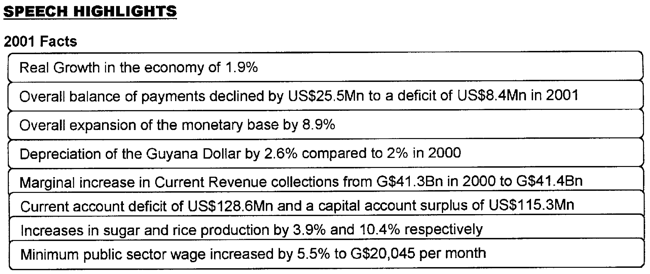
| Related Links: | Articles on budget 2002 |
| Letters Menu | Archival Menu |
INTRODUCTION
The second budget of the Eighth Parliament was presented by Minister
Saisnarine Kowlessar at its first sitting for the year 2002. Readers will
recall that the 2001 Budget presented on June 15, 2001 was described as a
half-year budget. The sitting was marked by the walkout by the entire
parliamentary opposition, the first time since the 1992 return to
democracy. In 2001 the PNC/R walked out of Parliament to protest the
presence of Mr. Doodnauth Singh S.C who was Chairman of the Elections
Commission for the 1997 Elections. This year the PNC/R along with their
opposition colleagues staged a similar walkout, this time to protest the
few, irregular and unproductive sittings of Parliament.
In what now
seems a policy in itself, the Minister announced that there were no new
taxes but there was some relief for cinemas and interior resorts.
In
2001, the Ministry of Finance saw a number of new faces including Mr.
Neermal Rekha as Secretary to the Treasury and Ms. L. Baird as his deputy.
Dr. Ashni Singh moved from the Office of the Auditor General to take up
the position of Budget Director, while the long-serving Winston Jordan
retained his position as Budget Advisor.
Despite the significant
appointments, Minister Kowlessar still appears to be working in the
shadows of President Bharrat Jagdeo who retains formal responsibility for
relations with the International Financial Institutions, and who also
makes most of the appearance and pronouncements which one would expect
from the Minister of Finance.
In his review of Global and Regional
Economies, the Minister referred to events of September 11, 2001 in the
US, coming at a time when the US had slipped into recession. Describing
the events as "acts of madness", he noted that security concerns have
leap-frogged the international agenda with 'foreboding" implications for
Guyana including postponement of the resumption of more robust growth in
the economy.
The overall effect was a downturn effect across the world
though a few countries including the UK performed creditably.
Unlike
last year when the Minister complimented those interest groups who
submitted proposals for tax relief and tax reform, this year he indicated
that the Government was "only able to accommodate those (submissions) that
will have a direct impact on the promotion of growth and the reduction of
poverty", hardly generous to all those who took the time and trouble to
make submissions.
While in the past two years the National Development
Strategy (NDS) was referred to as the principal planning document, the
Minister's reference to it appeared to subordinate it to the Poverty
Strategy Reduction Paper (PSRP) as well as the PPP/Civic Manifesto.
The
NDS was claimed to provide the holistic vision for development out of
which the PSRP was supposed to provide a meaningful participatory and
effective work plan for poverty alleviation and eradication. There was no
reference to the poverty reduction Strategy Credit (PSRC), a mechanism for
funding small-scale enterprises.
Once again, voluntarily bound as the
country is to the prescriptions of the IMF, the World Bank and Donor, the
budget measures, policies and targets offered no substantial changes and
again provided very few initiatives. Indeed, as noted on page 13 of this
review, prior issues were inexplicably dropped while others were
repackaged and restated with no indication of the reasons for their
non-implementation. Important issues such as labour participation and
unemployment appear to have achieved taboo status and for this year
Amerindian Affairs receives no attention.
Articulating perhaps the
Government's mission for Guyana, the Minister announced that the
government would continue to work towards transforming Guyana from a low
income, agricultural-dependence country to a middle income semi-industrial
one. He gave no indication of the time frame to achieve this or whether
the modest goal was a recognition of the country's special
difficulties.
Measured against the pre-budget expectations, the Speech
would be a great disappointment. For the fifth year, there has been no
movement in the income tax threshold with the effect that workers are now
bearing the cost of inflation not only in the goods and services they buy
but also in the nominal increases in their salary which make them
taxable.

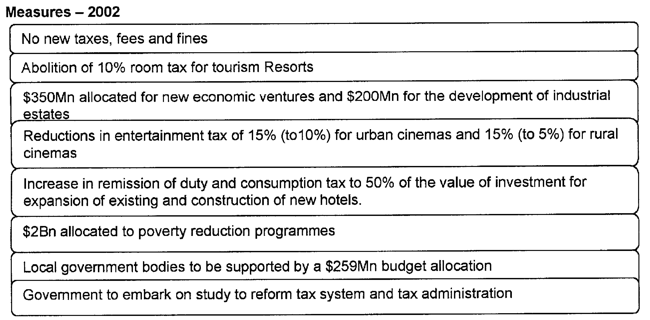
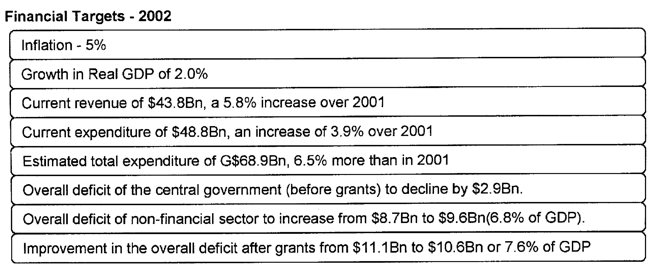


The Global Economy
There was real growth in the global economy of 2.4% (2000 - 3.9%) with growth of 1.1% (2000 - 4.2%) in the advanced economies and of 4% (2000 - 5.8%) in the developing economies. This resulted in a sharp rise in unemployment, particularly in the US. World trade grew by a meagre 1% compared with 12% in 2000. Regional growth was 0.5%, attributed to reduced activities following the September 11th attacks and the slowdown of the world economy. Of the Caricom countries only Guyana and Jamaica reported positive growth.
The Domestic Economy
The economy recorded a positive growth
of 1.9% following a contraction of 1.4% in 2000 and a positive overall
growth of 3.0% in 1999. In 1998, the economy declined by 1.3% following
positive growth in the preceding seven years.
The growth in 2001 was
due partly to improved performance in sugar and rice production by 3.9% to
284,474 tonnes and by 10.4% to 322,310 tonnes respectively.
The mining
and quarrying sector grew by 1.2%, with gold output being the major
contributor, with the highest declaration of gold by the industry,
surpassing by 4.8% the production target. Production of bauxite suffered a
significant decline to 2.01Mn tonnes, a decrease of 25.2%.
The
manufacturing sector grew by 0.2% as compared with a negative growth of
13.9% in 2000. The main contributors to the growth were the pharmaceutical
industry (4%), beverages (43.8%), footwear (79%) and garments (45.5%).
There were shortfalls in output of beer and stout (10.1%), malta
(7.8%), paint (2%) and plywood (26.6%).
The services sector recorded
positive growth in most of the sub-sectors particularly in transport and
communication which recorded a 5.5% growth. Engineering and construction
grew by 2.1% while distribution recorded marginal growth of 0.5%. There
was no growth in government services while financial services declined by
5%.
Per capita GDP for 2001 was US$737.9. (Per Capita GDP is the total
output produced inside a country during a given year divided by the total
population.)
Debt Relief
The country missed the completion point for the
Enhanced HIPC Initiative but benefited from debt write-off of US$6.97Mn by
the Commonwealth Development Corporation. In addition, the country hopes
to benefit from re-scheduling of debt with Canada and OPEC within the HIPC
Initiative.
Balance of Payments
September 11th weakened the balance of
payments position due to the falling commodity prices and high import
prices for fuel. Trade declined by US$13.6Mn. Earnings from exports
continued to decline as it did in 2000 mainly due to a decline of
US$15.3Mn in bauxite exports. Sugar receipts also fell significantly due
to the fall in the Euro, the currency in which a large portion of the
country's sugar output is sold.
Public Sector Investment
The Public Sector Investment
Programme (PSIP) again demonstrated an almost perfect achievement ratio of
99%, an increase of 8% over the rate in 2000. The key areas were roads,
bridges, air transport, sea defence, the agriculture sector and the social
sectors.
The Minister announced that 1,375 house lots were allocated
in various areas in 2001. This is a steep fall in the distribution of
house lots which were 22,500 in 2000 and 6,500 in 1999.
Banking and Interest Rates
The 91-day Treasury Bill declined
to 6.25% from 9.2% in 2000. Despite the significant reduction in
inflation, the weighted average lending rate of the commercial banks
remained almost unchanged at approximately 17% and the savings rate
reduced to 6.7% from 7.28%.
Loans and advances to the private sector
increased to $59.3Bn. Significantly, credit to the major economic sectors
declined.
The Exchange Rate
The exchange rate of the Guyana dollar to
the US dollar remained fairly stable, depreciating by 2.6% and settling at
$189.50 at year end. In 2000, the rate declined by of 2%.
Issues in the Financial Sector
The sector showed mixed
performances. The Government approved two additional institutions to offer
mortgage-lending services, but the country also witnessed the closure of
the Globe Trust Investment Company Limited, a non-bank institution which
accounted for less than 1% of the assets of the commercial banks.
Ram & McRae's Comments
The fall in inflation appears to
have as much to do with the monetary policy as with depressed demand due
to falling business and personal income.
The Minister was extremely
badly advised on the Globe Trust issue. The matter of a plan submitted for
Section 33 of the Financial Institutions Act is quite different from any
plan which the Bank of Guyana or an administrator develops under Section
49 which precedes any application for liquidation.
The Minister offered
no reasons for the country's failure to meet the Enhanced HIPC decision
points, any other implications for the failure and the steps being taken
to meet the conditions.
It is difficult to understand the annual
complaint by successive Ministers of Finance at the unresponsiveness of
the lending rates to the fall in inflation which means that the real rates
of interest are increasing. These Ministers seem to forget that they have
a controlling interest in a commercial bank and, through the Bank of
Guyana, can exert significant influence over the others. Ministers
certainly can appreciate that low inflation affects the real value of debt
service making repayment more costly.
2001 LEGISLATION
The National Assembly was extremely
inactive in 2001, enacting only twelve Acts and meeting for only nineteen
(19) sittings since the March 19, 2001 General Elections. Of the Acts
passed, three dealt with the General or Local Government Elections, six
with constitutional amendments, one with the Medical Practitioners Act and
one with the Appropriation of Funds from the Consolidated Fund.
Ironically, the only legislation directly affecting business was Act
No. 10 of 2001 which was to clear the ground for the acquisition of the
Water Street land of Toolsie Persaud Limited. The Head of the Presidential
Secretariat was reported as saying that the land was being acquired to
relocate the Water Street vendors by September 30, 2001.
Our Hard(ly) Working Parliament
The performance of the
Parliament in 2001 was by far the least productive for over a decade.
Ram and McRae's Comments
The situation in the National
Assembly is now so bad that one commentator has described Parliament as
"being in a coma". Indeed, the failure of Parliament to meet is one if not
the only reason for the walk out by the opposition members.
Up to the
time of the presentation of the Budget, there was no sitting in Parliament
in 2002. While important, debating the budget which in the final analysis
will be passed without amendment as has happened over the past 30 years,
is not the only function of Parliament. Indeed, even if our Parliament
were to work full-time, there might still be enough work to last more than
one year.
What makes the situation not only disappointing, but also
disgraceful is that it is the first time in the history of Guyana that the
country has a Minister dedicated to Parliamentary affairs.
For further
comments, please see Commentary and Analysis.
UNFINISHED BUSINESS
Every year, Focus tracks the
implementation of the key issues and policies identified in previous
Budget Speeches.
Disappointingly, last year's list, including the
policy issues and targets identified in the 2001 Budget, remains largely
untouched. We review these under two headings - repeats and forgotten.
Repeats
The following are unfinished policy issues from last
year which are repeated in the 2002 Budget:
* Completing a Tax Reform Study;
* Tabling legislation on bankable
property rights;
* Tabling new Procurement legislation and establishing
a new Procurement supervisory body;
* Reforming the Civil Service;
* Bringing a new semi-autonomous Deeds Registry into operation;
*
Improving institutional framework for trade and investment
facilitation;
* Appointing a Commissioner of Insurance and support
staff to enforce legal framework;
* Restructuring the rice, sugar and
bauxite industries in order to enhance their viability, their ability to
compete internationally and their net contribution to society; and
*
Diversifying the economic base for the purpose of stimulating investment
into new products and services in order to reduce the country's dependence
on the traditional production centers.
Forgotten
Prior year issues which seem to have been forgotten
are:
* Separating from core civil service 1,000 security guards;
*
Appointing a Director of Civil Aviation;
* Working with local and
international banks to provide pre- and post-shipment financing and other
related services to the manufacturing sector;
* Improving the welfare
of Amerindians by developing market networks in the Caribbean for
Amerindian art and craft;
* Launching of a Youth Employment
Programme;
* Supporting distressed companies - the only concerted
effort has been with respect to small operations in the rice sector;
and
* Establishing an NGO Co-ordination Unit.
Ram and McRae's Comments
The growing list of policies
abandoned along the way and/or not executed raises serious questions about
the co-ordinating function and executing capabilities of the several
Ministries of Government.
Some years ago, it was announced that a
leading advisor to the President when he was the substantive Finance
Minister was being transferred to the Office of the President with
specific responsibility to monitor the implementation of policies. Perhaps
this task should be assigned to a Parliamentary Committee.
While there
is a clear imperative for civil service reform, it would be meaningless if
this did not have as one of its objectives the reduction in the number of
ministries. How can a small country as ours afford two Ministers of Local
Government, a Minister of Foreign Trade and a Minister with responsibility
for Parliamentary Affairs?
It seems that considerably more work has to
be done to make Go-Invest a one-stop shop rather than just another layer
of bureaucracy slowing up the work of the Ministries of Tourism and
Finance.
No meaningful restructuring of the rice industry can take
place without measures to address the financial difficulties facing the
large operators in the industry. The assistance of the small farmers while
welcome does not solve the problem of the industry or the bankers. It is a
systemic problem warranting an inclusive solution.
2002 POLICY ISSUES & TARGETS
In introducing the
Government's "key tasks and policies in 2002 and beyond", the Minister
announced that the process of creating jobs and rapidly increasing the
income levels of Guyanese on which the government has embarked, would be
accelerated through the efforts of the opposition members of Parliament
and all stakeholders in preserving peace and stability.
1. Maintenance
of a stable macro-economic framework.
The Minister identified the
following specific policies:
(i) Monetary policies to maintain the
stability of the exchange rate, contain inflation, safeguard the Bank of
Guyana's external reserve position and support the Bank of Guyana in its
quest to reduce interest rates further.
(ii) Fiscal policies to support
growth, reduce poverty and increase public sector savings. Specific
measures include a comprehensive review of the tax system and staffing the
Revenue Authority to its full complement.
2. Private Sector
Development
* Assist the private sector in export and investment
promotion, and expansion of small business and cottage industries and
enact small business legislation.
* Appoint a Commissioner of
Insurance
* Establish dispute resolution and settlement mechanism
*
Establish a Stock Exchange
3. Restructuring the economy
(i) Sugar:
Begin massive restructuring and modernisation of Guysuco at a cost of
US$110M and resulting in increased output to 450,000 tonnes per annum at a
cost of production of US$0.11 per pound of sugar over five years.
(ii)
Rice: Development of an integrated sustainable and profitable industry
under a 10-year strategic plan initiated by the Guyana Rice Development
Board. The plan has four key areas: research and development, improved
processing methods, expanding/developing markets and support service
including drainage and irrigation, land reform, finance and inputs.
(iii) Bauxite: Noting the Government's repeated attempts to sell the
two main state owned bauxite companies, the minister announced his
government's commitment to a complete restructuring of the sector.
(iv)
Forestry and Gold: No initiatives.
(v) New Growth Areas
Priority areas identified includes:
(i) Manufacturing: the
development of government manufacturing plants, in agriculture, the
fisheries, other crops, cut flowers and agro processing.
(ii) Tourism:
The establishment of the Tourism authority and revamping the incentive
regime.
(iii) In Technology, taking steps to attract investors to this
sector including tele-centres.
(iv) Job Creation:
(1) Short-term
programmes to provide cash and other support to displaced workers.
(2)
A temporary employment and maintenance programme to employ 300-400 persons
under a contract for G$1,600M which has already been awarded and works out
at approximately G$4M per person which suggests that the contractor will
be making a huge project
4. Transparency and Efficiency
Ministry of
Finance, including the State Planning Secretariat will be strengthened to
formulate and implement policies.
Once again the Ministry has announced
new legislation on public procurement and tendencies and a new audit act
in 2003.
The Government proposes comprehensive amendments to the FIA
and Bank of Guyana Act to prevent some of the excesses which surfaced in
Globe Trust.
Establishment of a Financial Stability Unit through the
scope and objective of such a Unit is unclear.
Ram & McRae's Comments
There is a commitment by the
government to put in place an Audit Act by May 1, 2002 as part of an IMF
conditionality.
The Minister appears unaware that it is not only the
absence of legislation but also the weakness and timidity of regulators
which sometimes permit excesses to continue longer than they should.
An
announcement has recently been made that the Stock Exchange would go into
operation by mid-2002 which appears to be a highly optimistic
target.
The Minister appears to ignore the recommendations of the
Auditor General that the State Planning Commission be formally dissolved
since it now operates as a Department within the Ministry of
Finance.
Similarly, the Estimates provide for subsidies to be given to
several Departments which operate improperly outside of the Government's
pay structure as well as entities which are delinquent in meeting their
obligations to have their books audited. It seems improper for the
Government to be condoning such misconduct.
The Government is
committing itself heavily to the Sugar Industry. The assets employed are
quite substantial as are the social considerations. It will be relying
heavily on the managers delivering the expected output.
THE GOVERNMENT OF GUYANA FINANCIAL PLAN 2002
The table on the
page 21 presents a summary of the Government's projected financial plan
for 2002. Some of the 2001 figures, which appeared in the 2001 Estimates,
have been restated in the 2002 Estimates without any explanation. The Plan
projects a negative current balance of G$2.052Bn after taking interest and
current expenditure from current revenue, compared with a negative balance
of G$1.942Bn in the 2001 Budget. This is a major turnaround from a
budgeted surplus of G$1.393Bn. The principal elements of the 2002 Plan
are:
Current revenues are projected to increase to G$43.790.3Bn in 2002
from G$41.426.2Bn in 2001. The Revenue Authority projects an increase of
G$3.134Bn or 8.3% over 2001 and now hope to bring in 93% of the total
current revenue. In 2001, the Revenue Authority realised decreased
revenues of 0.79% over the previous year and fell short of budget by
4.45%. Although collections in 2001 over 2000 of the Internal Revenue
Department increased by G$0.719.1Bn or 3.6%, the Customs and Trade
collections decreased by G$1.021Bn or 5.6%. The Minister explained that
the lost revenue from the Customs and Trade Administration was due to the
reduction in international trade from the September 11 aftermath.
Total
Current expenditure is projected to increase by 5.23% from G$35.375Bn to
G$$37.228Bn in 2002. It is made up of interest expenditure of G$8.615Bn or
19% (2001-18.43%), personal emoluments of G$15.814Bn or 35% (2001- 34%)
and other charges of G$21.413Bn or 47% (2001- 48%). The main allocations
of the non-interest expenditure were the Ministry of Finance 14.14%,
Ministry of Education 11.21%, Ministry of Home Affairs 9.63%, Guyana
Defense Force 7.60% and Ministry of Health 6.29%.
There are several
significant projected changes in the allocation of certain expenditure in
comparison to the 2001. Major decreases over 2001 include: Office of the
Prime Minister (60)%, Elections Commission (36.7%), Ministry of Finance
(8.59)% and Ministry of Housing and Water (8.61)%.
Significant
projected increases over 2001 include Ministry of Health G$1,213Mn,
Ministry of Labour, Human Services and Social Security G$739Mn, Ministry
of Education G$606M, Guyana Defense Force G$334Mn, Ministry of Public
Works and Communications G$227Mn and Ministry of Home Affairs G$244Mn.
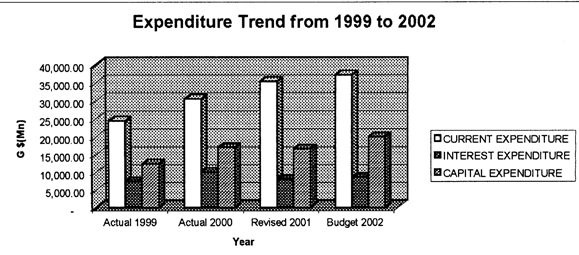
For further details of allocation of non-interest expenses
please refer to page 22.
Total interest expenditure is projected to
increase by 7.8%% from G$7.993Bn in 2001 to G$8.614Bn in 2002 or
approximately 19.67% of current revenue compared with 19.29% in 2001.
Interest on domestic and external debts is projected to increase by 5.4%
and 11.3% respectively.
Capital revenue is projected at G$9.822Bn
(2001-G$5.716Bn) and capital expenditure at G$19.954Bn (2001-G$16.511).
The revenue figure is made up principally of HIPC grants ($6.363Bn) and
Project and Programme funds ($3.387Bn).
Capital expenditure of
G$19.954Bn represents a 21% increase over 2001. This follows a decrease of
3.6% in 2001 and an increase of 37.9% in 2000. The proposed allocation of
the capital expenditure includes Ministry of Public Works and
Communications 21%, Ministry of Education 13.93%, Ministry of Finance
23.36%, Ministry of Housing and Water 11.78%, Ministry of Agriculture
4.97%, and Ministry of Local Government & Regional Development
4.86%.
Debt repayment is projected at G$3.021Bn (2001-G$3.064Bn) made
up of domestic debt repayments of G$176.6Mn and external debt repayments
of G$2.844Bn, representing increase of 75% and decrease of 4% respectively
over the previous year. There is an overall deficit of G$15.2Bn compared
with a deficit of G$15.8Bn in 2001. It is projected that the deficit will
be financed from domestic and external sources of G$3.96Bn and G$11.2Bn
respectively. The overall balance of deficit before grants is projected at
G$25.03Bn which is G$3.51Bn more than the deficit of G$21.52Bn in 2001.
During 2002, Domestic and External Debt Service as a percentage of
current revenue is projected at 26.6% compared with a revised percentage
of 26.7% in 2001 and 38.6% for the preceding year.
Ram and McRae's Comments
It is surprising that the 2001
Budget presented in mid-2001 could be so wide of the mark. Instead of a
positive budgeted current balance of G$1.392Bn, the actual results were a
negative balance of G$1,942.3Bn. The principal factors contributing to
this turnaround were a decrease in current revenue of G$2.592Bn, and an
increase of current expenditure of G$1.842Bn. The deficit would have been
greater had there not been a lower than budget charge for domestic and
external interest repayment of G$1.098 or 12%.
The composition of
projected revenue for 2002 is essentially the same as 2001. Corporation
Tax fell slightly in 2001 compared with 2000.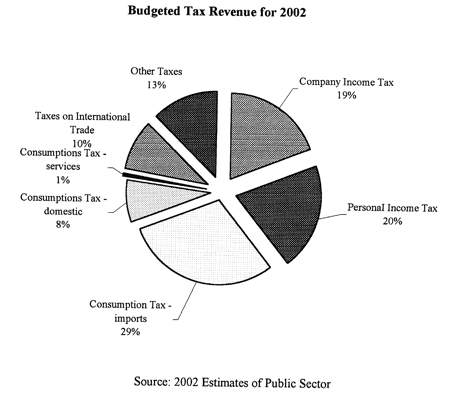
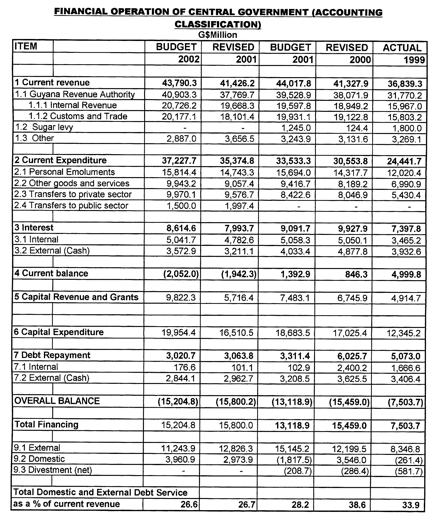
WHO GETS WHAT IN 2002
Current Non-Interest
Expenditure
In this section we consider how the budgeted
expenditure is allocated among competing Ministries, Departments,
Programmes and Projects.
Central Government's non-interest current
expenditure (employment costs and other charges) for the year is budgeted
at G$34.6Bn which is 0.8% below the revised 2001 amount. The Ministries/
Departments with the most significant allocations are: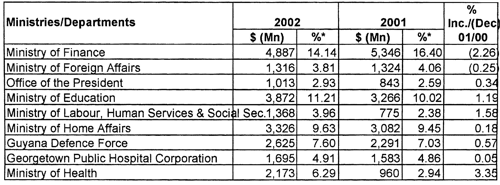
* Percentage of
total current expenditure
Not unlike last year, the Ministry of
Finance, the Ministry of Education, the Ministry of Home Affairs and the
Guyana Defence Force receive the most significant allocations. Separate
allocations are provided for the Ministry of Foreign Trade and
International Cooperation and the Ministry of Amerindian Affairs.
The regions with the most significant allocations are: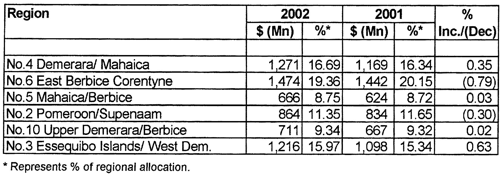
* Represents % of regional allocation.
Significant changes from the
previous year's latest estimates occurred in the following Ministries/
Departments:
The substantial increases in the allocations for the
Ministry of Local Government and Regional Development; the Ministry of
Tourism, Commerce and Industry; the Ministry of Health; the Public Service
Ministry and the Ministry of Labour, Human Services and Social Security
were because of the restructuring of the ministries and the
discontinuation of the Ministry of Local Government, the Ministry of
Trade, Tourism and Industry, the Ministry of Health and Labour, and the
Ministry of Human Service & Social Security.
Capital Expenditure
Central Government's capital expenditure
for the year is budgeted at G$21.5Bn which is 15% above revised 2001 and
36% of total 2001 expenditure. The Ministries / Departments with the most
significant capital expenditure allocations are:
The Office of
the Prime Minister receives no allocations for 2002. The largest increases
are in the following Ministries: the Ministry of Finance (125%), the
Parliament Office (67%), the Ministry of Health (64.5%), the Ministry of
Local Government and Regional Development (52%), the Supreme Court (50%),
the Ministry of Labour, Human Services and Social Security (40%) and the
Public Service Ministry (100%) had the most significant increases in
allocations. The substantial increase in the capital budget for the
Ministry of Finance is due to an allocation of $1,228Mn for the
rehabilitation of GUYSUCO and a $1,500Mn loan to LINMINE.
Regional
Allocations
Once again Region 6 (East Berbice/Corentyne) whose share
of the country's population is about 20%, received approximately 20% of
the total current expenditure amount allocated to the regions. The
situation regarding the total expenditure allocation is similar. Region 6
gets 19% while the even smaller Region 3 (Essequibo Islands/West
Demerara), with a population share of 12.5% gets 16% of the amount of the
regional expenditure, up from 14.2% in 2000. On the other hand, Region 4,
with 42% of the country's population receives only 16% of the total
expenditure allocated to the regions.
Ram & McRae's Comments
These percentages remain largely
unchanged from the previous year. Region 4 has the greatest unfavourable
disconnect between population and expenditure while Region 6 receives an
allocation that is almost commensurate with its population.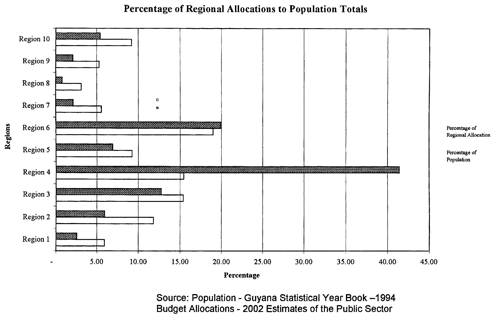
2002 BUDGET MEASURES
COMMENTARY AND ANALYSIS
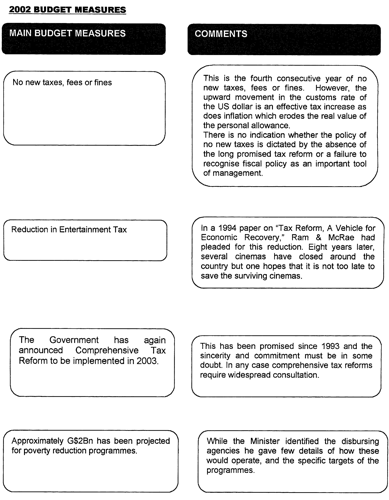
Income Tax Threshold
The Government appears to have
experienced some difficulty in concluding its Budget for the current year
and missed several target dates going back to January 2002. The Budget
when measured against expectations would be a great disappointment as it
offered none of the wishes or concerns of stakeholders. It seems
unbelievable that the Government would leave the threshold of the personal
allowance untouched for four consecutive years. The current allowance
granted was set in 1997 and is therefore worth approximately G$23,000
which is within the 20% tax rate.
It is hard to believe that the
Government's failure to respond to the popular and universal request as
insensitivity. It seems more reasonable to assume that the IMF would have
insisted on this position given the state of the economy. This is the
price we pay for abandoning our economic sovereignty to an institution
where poverty and its alleviation seem to be more concepts than reality.
It is also the price we pay for pursuing a policy of debt relief rather
than growth and development.
So entrenched are we in the IMF Programme
that we have no exit strategy and in that case we simply have to submit to
all their conditionalities.
Over the past several years, the country's
economy has deteriorated substantially and the projected growth rate of 2%
is inadequate to take us out of our current state of poverty. Our per
capita GDP has stagnated against a dream of doubling it within 10 years
which would have required a compounded growth rate of 8% per annum. Over
the past several years, the Government has developed a warm relationship
with the private sector and appears not to have any regular dialogue with
the labour movement. While the slowing of the inflation rate protects the
workers' income and savings, even modest increases in income to compensate
for inflation can take the income into the taxable bracket.
Failure to
address the threshold therefore is likely to be a huge disappointment not
only to employees, but to employers as well since the burden of
meeting.
Debt
There is much that has been written about the country's
debt problem and much of the credit for the substantial debt relief from
which the company has benefited is claimed by the current Government.
Indeed, the President claimed that when the PPP/C came to power the debt
service ratio was some 90% of export earnings. The reality is slightly
different, largely because of the way the numbers were being computed. The
IMF insists that public estimates be drawn up as though all scheduled debt
services would be met. In practice however, Guyana had for several years
not been meeting its obligations to creditors and the Hoyte Administration
had initiated action to reschedule maturities of principal and interest
payments falling due between January 1, 1989 and December 31, 1994.
In
1989 the country had total debts of US$1.9Bn, of which a significant
portion represented arrears. As a result of the approaches to the
international community and the buy-back of certain debts, by October 1992
the country had cleared most of its arrears and its debt service ratio
would had been reduced to 33%.
Many Guyanese may not be aware as well
that for several years prior to 1992, Guyana had not been paying its
indebtedness either to the international financial institutions or to
commercial creditors. Accordingly, it had not been possible for the
Government, particularly during the years 1985 to 1990 to borrow any money
or to contract commercial credit. Questions like where did the $2.1Bn go
must be considered extremely ill informed since a substantial portion
represented interest and penalties for non-payment over several
years.
Since 1992, Guyana has made remarkable strides in obtaining debt
write-off but the cost has been significant since it required a commitment
on the part of the Government to meet its re-scheduled obligations. During
the period since 1992, the country has borrowed approximately US$600Mn of
external debt while its domestic debt has increased from $18.1Bn to
$49.7Bn!
In the process, we have paid out interest of G$39.3Bn on our
total external debt and G$40.0Bn on our internal debt for the period
1993-2001. Debt management will remain a critical issue for our
policy-makers for years to come. Accordingly, we must follow basic
principles that ensure that we utilise borrowed funds on projects and
programmes which at a very minimum produce financial and/or economic
returns to enable the country to service those debts.
Businesses in Distress
In his 1999 Budget Speech, Minister
Kowlessar announced his Government's intention to assist businesses in
distress. Despite systemic business failures affecting rice, lumber,
manufacturing, gold and even the commercial sector, the Government has
shown a marked reluctance to intervene, even when problems could spill
over and threaten the financial system - the very foundation of an
economy.
Even as the Minister was preparing to go to Parliament to
present his 2002 Budget, he would have noticed that another three leading
businesses had been taken to Court because of their inability to meet
their obligations to their creditors. About 1,300 borrowers in the rice
industry owe approximately $15Bn to the commercial banks of which
approximately 1,200 account for about 10% of the indebtedness. Despite the
integrated nature of the industry, the Government only assisted the small
operators, leaving the large players to make their own case with their
bankers. The Minister needs to revisit his stated commitment to distressed
businesses and recognize that given the systemic difficulties which
several industries are experiencing, only Government intervention and the
co-operation of the bankers can stave off further business failures and
costly shocks to the economy.
The Investment Code
The Government on numerous occasions had
committed itself to a legally enforceable Investment Code and the Minister
proudly announced in his Budget Speech that his Government had tabled such
a code in Parliament. The Code tabled however was not a legally
enforceable document and excluded many of the strong provisions of the
Draft Code which had been the subject of widespread consultations. Some of
the provisions which were taken out included steps to lend transparency
and certainty to the issue of tax concessions which is now purely a matter
of political discretion; a more streamlined Go-Invest and clearer roles
for investment. The Government appears to have lost a number of points as
well as credibility as a result of its failure to honour a commitment made
to the international community. In order to restore credibility with
donors as well as investors, the Government needs to revisit the Code.
Corruption
The Minister spoke about the need for transparency
and efficiency of the economy. In this connection, Parliament has already
passed laws to strengthen the Office of the Auditor General giving it not
only greater resources, but also legislating for its stronger
independence. Despite taking some steps to deal with corruption, the
Government is still perceived to be soft on the issue. Corruption however,
is not limited to the Public Sector and while many consider that
corruption persists in matters of tender procedures, procurement and tax
revenue transactions, some action needs to be taken to deal with
corruption in and by the private sector. In this connection, some new
forms of audit arrangements, legislation to encourage whistle-blowing and
stronger penalties to deal with wrong-doers need to be considered.
Budget Process
Over the past several years, Parliament has
been called upon to approve substantial sums of money which had already
been expended. While this may be partly due to emergency or failings in
the budgeting system, the extent has been so pervasive that it seems to
cast doubt on the entire Parliamentary approval system. New forms of
constitutional arrangements may be necessary so that a built-in Government
majority cannot automatically approve sums which did not fall within the
rules. The graph below shows the extent of sums for which Parliament gave
subsequent approval:
Total Supplementary Funds Approved (TSFA)
The Role of Parliament
Guyana operates a Parliamentary
democracy, but the records show that Parliament has been found wanting.
During the entire nine months following the March 2001 elections,
Parliament met on a total of 19 occasions with half of those dealing with
the 2001 Budget. Guyanese invested greatly in constitutional reform and
looked to their Parliament to chart a course for national development.
Every Guyanese must feel that he/she has been betrayed by the Parliament.
It is time that this situation be rectified since there is no acceptable
alternative to Parliament. Our Parliamentarians must get to work.
CONCLUSION
Measured against the expectations prior to the
Budget, the Budget must be a great disappointment. The Budget Speech
contains no indication that it recognises that the economy is in trouble,
that it needed a jump start and that this was an excellent opportunity for
the Government to show that it was truly managing the country's
economy.
Last year, we concluded our review by asking that Parliament
and the Opposition to exert greater influence over the financial system
and the financial resources of the country. The Auditor General's Report
for 2000 has still not been tabled nor are the accounts of many entities
funded by taxpayers' money. Civil society and all taxpayers must demand a
higher standard of accounting and accountability from those to whom we
entrust our scarce resources.
The indications are that the
international community is becoming slightly concerned about the level and
quality of financial management in our country. We cannot let them lose
confidence and therefore withhold their support.